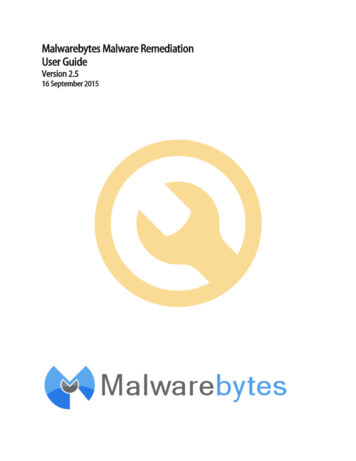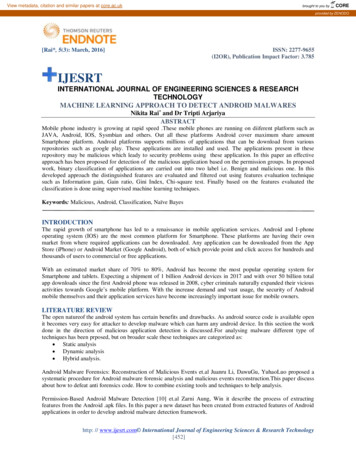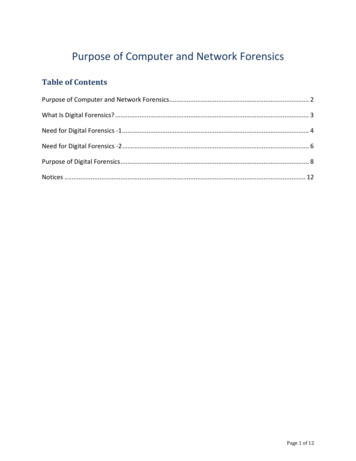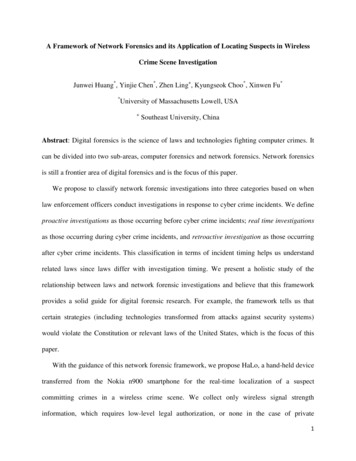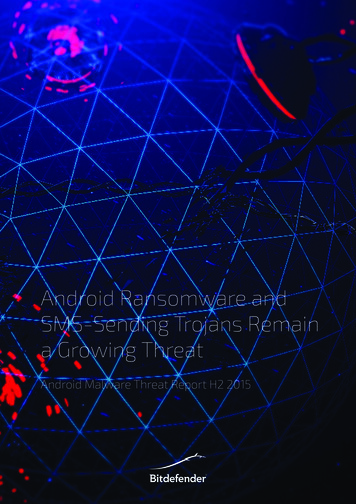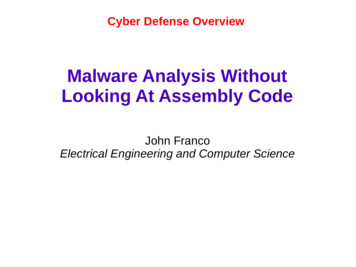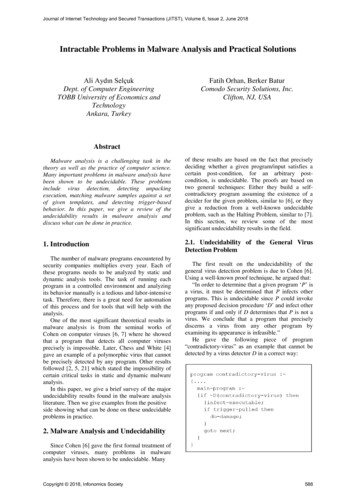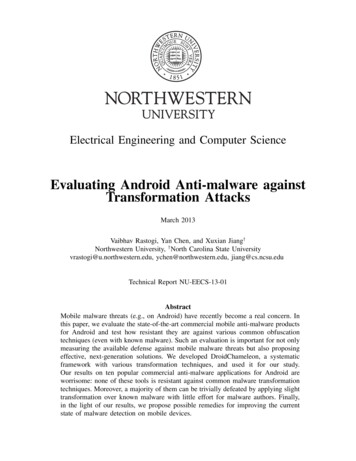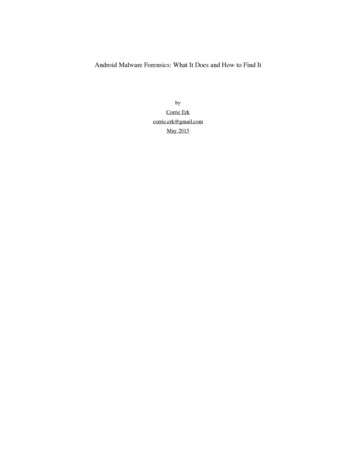
Transcription
!!Android Malware Forensics: What It Does and How to Find It!byCorrie Erkcorrie.erk@gmail.comMay 2015!!!!!!!
!ABSTRACTCyber threats have in recent years expanded to target the technology thatcontinues to be released and developed. Now, desktop devices are not the only threat formalware, but mobile phones are the new, up-coming target. Mobile forensics in general isstill in its infancy when it comes to acquisitions and analysis, as is reverse-engineeringthe malware targeting these devices. With Android devices holding the majority market ofmobile users, the most mobile malware being created (while not very sophisticated)targets these devices specifically. After testing two samples of Android malware, patternsin Android malware behavior are developed, as well as how to forensically analyzecompromised devices. It is found that rooting an Android device and taking a physicalimage of the device will provide the most information related to a compromise and themalware itself. The common folders related to applications can be analyzed to findmalware artifacts; the data folder, the downloads folder, the app and app-lib folders, andthe dalvik-cache folder. Evidence of malware can be found in these locations, andsuspicious files can be extracted and reverse-engineered to read the raw code of themalware to have a full understanding of what its functions are.!!!!2
!TABLE OF CONTENTSABSTRACT.2INTRODUCTION .5PROPOSAL .6BACKGROUND .7ANDROID MOBILE DEVICES .7Partitions .7Application Architecture .8Android Forensics .9CYBER THREATS .10Android Malware.11MALWARE ANALYSIS .13METHODOLOGIES.14MOBILE PHONE .14FORENSIC MACHINE(S) .15PROCEDURES.15FORENSIC COLLECTION .19FINDINGS .22MALWARE SAMPLES .22Godwon .22Social Path .23STATIC ANALYSIS .23Godwon .24Social Path .26BEHAVIORAL ARTIFACTS.29Godwon .29Social Path .30FORENSIC ARTIFACTS.32Downloads Folder .32App Folder .33Data Folder.34App-lib Folder.36Dalvik-cache Folder .37CONCLUSION .38BEHAVIORAL PATTERNS .39FORENSIC PATTERNS .40TRIAGE RECOMMENDATIONS .41FUTURE RESEARCH .41WORKS CITED .44!3
!!4
!INTRODUCTIONThe use of technology in the 21st Century has evolved exponentially, providingtools for people to learn, work, connect with one another, and entertain in a convenientand efficient manner. With this growing technology becoming a mainstream part of dailylife, people rely more heavily on the use of their mobile devices, which incorporates away for users to accomplish all of their daily tasks. In the cyber world, the heavy relianceon mobile devices by a large population causes the amount of malware being created andtargeting these platforms to increase. A mobile threat report released by the securitygroup Lookout revealed that the number of Android mobile phone users who becameinfected with malware increased by 75% between 2013 and 2014 (Lookout, 2015). Thesetypes of malware function as spying devices, and include ways to steal personalinformation or commit fraud. In June of 2014, a mobile malware family calledWireLurker surfaced in the cyber world, which created scares across the security industrybecause of its sophistication in infecting cross-platforms (Mac OS X and iPhone) as wellas being discreet in that it does not require the mobile devices to be Jailbroken to gainadministrative access with reduced security measures (Palo Alto Networks, 2014).One large issue surrounding mobile malware threats in the forensics industry istrying to identify what the malware is and what it has done with the device. Was it usedas a listening device? Was it used to commit a cyber crime? Were data and other privateinformation exfiltrated? These are all questions that are asked during a malware infectionof a normal desktop device, and those questions remain the same for compromised!5
mobile devices as well. At this time, the forensics community is at a benefit in thatAndroid malware and other mobile threat types are not nearly as sophisticated as they arefor Windows platforms. The command and control mechanisms used often do notfunction as expected, and the configurations are not flexible and unpredictable.Additionally, the malware will take limited steps to concealing itself, therefore leavingidentification of the infection as a relatively easy task (Peters, 2014).On a Windows device, malware saves its payloads and configurations to commonplaces on the device, such as the user’s AppData folder, or the Windows Temp folder.These are popular places to look when first attempting to identify a compromise. Patternssuch as these are not currently documented, as the research around mobile malwarefamilies are still in its infancy.Further research needs to be performed on mobilemalware in order to create a set of standards for how forensic analysts can examine thesecrimes. Additionally, patterns need to be discovered to better analyze infected devices aswell.PROPOSALThis project will serve to provide information about Android mobile devicemalware, as well as what to look for when forensically investigating a potentially infecteddevice. Malware forensic techniques and artifacts for the Android operating system willresult from research and testing performed.!!!6
!BACKGROUNDANDROID MOBILE DEVICESThe Android mobile operating system is a platform acquired by Google in 2005when the company was just a startup (Elgin, 2005). In the past ten years, the platform hasbecome the most commonly used mobile operating system, being supported not just onsmartphones, but tablet computers, televisions, cars, and even wrist watches. In additionto making phone calls and send or receive text messages as a normal cellular devicemight, Androids use applications to add a variety of functionalities and purposes to thesmartphone. The operating system is open source, meaning that the source code isavailable to developers who can create modifications and applications that allow users toutilize the device in a way that’s best fit for them.PARTITIONSAndroid devices contain multiple partitions to store data. The internal partitionsconsist of boot, system, recovery, data, cache, and misc. (Raja, 2011). /boot: Contains the phone’s kernel and ramdisk required to make the phone boot. /system: Contains the operating system, including the user interface and systemapplications that are pre-installed on the mobile phone. /recovery: Stores a second boot option used for maintenance and recoveryoptions.!7
/data: Also known as the USERDATA partition, contains the data related to theuser, including contacts, messages, settings, applications, etc. /cache: Contains frequently accessed data and application components /misc: Contains miscellaneous settings to be turned on or off, such as hardwaresettings.An external partition, /sdcard, may also be present representing a SD card often usedas extra storage space for applications, media, documents, etc.APPLICATION ARCHITECTUREAndroid applications are developed in Java, and then are compiled into anapplication package file commonly known as an APK file (the file extension being .apk).An APK file is similar to a zip archive, containing a directory of files required by theapplication. This directory of files can be viewed by adding a “.zip” to the end of the filename, and using a zip file program to extract the files.Once unzipped, the APK contents will include the AndroidManifest.xml, which isrequired to be located in the root directory of every application. This XML file containsapp information for the operating system, such as package names for Java, applicationcomponents and which processes host those components, permissions, versions, libraries,etc. (Android Developers, 2015). The zipped APK may also include applicationcertificates, libraries of compiled code, application resources and assets, and javacompiled executable files (.dex files).!8
FIGURE 1: APK CONTENTS Applications (more specifically, .dex files) are executed in their own DalvikVirtual Machine (DVM) to run the Dex bytecode (translated from Java bytecode) of theapplication (Hildenbrand, 2012). Having each application contained to their own DVMallows for multiple applications to be run at the same time, and restricts what eachapplication can access on the rest of the system with or without permissions from theuser. (Barrett, 2014).ANDROID FORENSICSMobile forensics in general is a fairly new specialty in the digital forensics field.Although, between the large mobile phone operating systems used today (Android, iOS,Windows, and Blackberry), Android may be the operating system that is easiest toacquire and analyze in the field due to its open source nature. The mobile companyCellebrite1 provides forensic solutions to enable analysts to acquire, parse, and analyzedata on most cellphones and smartphones available in the market. Cellebrite’s UFEDsoftware allows for three types of acquisition for Android devices; Logical, File System,and Physical.1 http://www.cellebrite.com/!9
Logical acquisitions will collect the least amount of data, but will include SMSdata, contacts, call logs, and media on the device. File System collections include the datafrom a logical acquisition, but also can collect standard files, including those which arehidden. Lastly, physical acquisitions collect all of the above information types, but alsoinclude deleted data.In order to access the full data on a device, Androids need to be rooted. Rooting adevice gives the user full privileges and control on the device (root access) with access toany file or folder on the device. Without root access, many files and partitions are hiddenfrom acquisitions and analysis. Therefore, it is common to see analysts root Androiddevices before acquiring them, in order to ensure the most data is captured andaccessible.CYBER THREATSFifteen years ago, the integration of technology in the daily lives of the populationwas not nearly as prevalent as it is now. Over three billion people in the world have anInternet connection, compared to fewer than half a million users back in 2000 (InternetLive Stats, 2015). This means that approximately 40% of the world’s population issusceptible to cyber attacks. These attacks can often include the exploitation ofvulnerable network and technology infrastructures, malicious emails social engineeringrecipients into revealing personal information such as passwords or credit card numbers(a method known as phishing), sniffing network traffic to collect information transferredthrough the Internet, and tricking users into installing malware on a system. These types!10
of attacks happen every day, as displayed by a cyber map put together by the securitycompany, Norse, found at http://map.ipviking.com/.In 2014, the computer security company Sophos released a Security Threat Trendsreport predicting the cybersecurity concerns of 2015. The predictions include more flawsin widely-used software that have gone undetected in previous years, new rootkits andbots infecting devices using different methods than in the past, and an increase in attacksagainst mobile platforms. Of the mobile threats, a focus on exploit kits targeting mobilepayment systems to collect credit and debit card information is expected to increase(Lyne, 2014). The predicted focus on mobile platforms is caused by the increasinggrowth in the use of smartphones as a tool to pay for products and services, store personalinformation, and communicate such personal information to one another via email or text.ANDROID MALWAREWhen the smartphone market was analyzed at the conclusion of 2014, it wasfound by the International Data Corporation (IDC) that the Android operating systemheld 81.5% of the smartphone market share (IDC, 2015). In addition, Forbes released anarticle stating that 97% of mobile malware can be found targeting Android devices(Kelly, 2014). This is not a coincidence. Malware creators want to target the largestpopulation of users as possible when creating an attack for it to be the most effective,which is why Windows devices have more susceptible to malware than Mac devices inthe past. In the smartphone world, Android’s open source architecture and majority usersallow for the development of cyber attacks to these devices to be the most beneficial.!11
In addition to the ease in development and the high market, there are limitedrequirements for uploading an application to the Google Play Store. According to thesupport page on Google’s website, a user only has to go to their own Google PlayDeveloper Console, click “Add new application,” select a name and language preferencefor the app, and upload the APK. The only security requirement is for the application tohave debugging disabled before publishing in the store (Google Play, 2015). Therefore, itis relatively simple for a user to upload and publish malicious applications. Although,Google has recently begun scanning applications as they are uploaded to Google Play inorder to detect and remove malicious instances found in the store. Users also have theability to disable app-specific security controls, which would prevent a user frominstalling applications that are not sourced from the Google Play Store (such as externalwebsite downloads).There has been a noticeable increase in malware found in the Google Play Storein recent years. Between 2011 and 2013, the number of mobile applications infected withmalware discovered in the store nearly grew 400% (Miners, 2014). Most of the malwaredetected both internal and external to the Store are used to advertise or promote otherproducts and services, and collect information stored on the phones (device IDs, contacts,text messages, GPS coordinates, email addresses, phone conversations, credit cardnumbers, etc.) which can later be sold to third parties or used against the victim’s will.Although, analysis of Android-specific malware thus far has shown that theinfections do not always take immediate action, or take action at all. Most malwarediscovered remains dormant for a period of time, sometimes as long as a month, before!12
any symptoms are recognizable to the user. A recent infected app, called Durak, was acard game application, which waited 30 days before pushing threatening pop-upadvertisements, scaring the user into thinking they needed to perform a security update orfix to their phone, when ultimately they were led to other malicious websites to downloadmore malware, or asked to provide credit card information to remediate (Olivarez-Giles,2015). Additionally, Android malware has been relatively immaturely created and lacksophistication compared to their Windows counterparts. The command and controlmechanisms hardcoded into the applications often do not work properly which defeatsmany purposes and functionality of the malware. The samples studied thus far also do notshow any methods to conceal itself while installed (Peters, 2014).MALWARE ANALYSISIn the information security world, having the skills or a service to analyzemalware has become a must in many companies. The purpose of reverse-engineeringmalware is to have an understanding of what the malware does. What is its functionality?What is the threat? What can be done to prevent it? How can it be detected outside ofAnti-virus? What needs to be done to remediate the threat? There are several automatedservices available for purchase and for free which will analyze malware to help answerthese questions, or those with enough resources can build a sandbox environment in orderto answer these questions themselves.Behavioral analysis of malware is a process of scrutinizing the malware todetermine what it is meant to do. One way this can be done is through static analysis,where the code is reverse-engineered to understand what it was designed to do without!13
execution. A second method is to perform dynamic analysis, where the sample isexecuted in a secure environment and monitored to collect information of how it behavesin-action (Erk, 2014). These practices are commonly applied when investigating malwareinfections on desktop devices (such as Windows or Mac operating systems) but thepractices can be applied to other platforms as well with variations in tools used toperform the analysis.!!METHODOLOGIESMOBILE PHONEThe mobile phone used to perform this research is a Samsung Galaxy S4 runningAndroid Kit Kat version 4.4.2. The phone is configured to disable the built-in securitysettings, which would prevent malicious files from being downloaded and installed on thephone. Additionally, the phone is rooted using an application called Towelroot2.Towelroot allows a user to root an Android device with the press of a button. Disablingsecurity features on the phone allows for the malware to easily be installed on theSamsung device, while rooting the mobile phone allows access to the system’s fullcontents, which are required for imaging and analysis.2 https://towelroot.com!14
FORENSIC MACHINE(S)The forensic machine used for acquisition of the phone and analysis is a desktopdevice running Windows 7 Professional. Installed on the machine is a suite of tools byCellebrite, including UFED4PC for imaging, and UFED Physical Analyzer 4 for analysis.The handling of malware was performed on a Macbook Air running OS XMavericks. Android File Transfer for Mac is installed on the device to aid in moving theAndroid malware samples to the Samsung device to be installed.!!PROCEDURES1. Perform a factory reset on Android devicea. Power down the deviceb. Hold the volume up button, power button, and home buttonsimultaneously until the Samsung logo appears. Then release.c. When the Android System Recovery screen appears, select “Wipe Data/Factory reset”d. Select “Yes – delete all user data” to confirm wipee. Device will restart!15
2. Setup device and disable security featuresa. Go to Settings Security and ensure “Unknown Sources” is checked toallow apps to be installed outside of the Play Store and uncheck “VerifyApps” to prevent the blocking of potentially malicious applications FIGURE 2: SECURITY SETTINGSb. Enable developer options by going to Settings About Device and tapping“Build Number” repeatedly 7 times.c. Go into Developer Options under Settings, enable “USB Debugging” andensure “Verify apps via USB” is disabled!16
FIGURE 3: DEVELOPER OPTIONS3. Root the phone to ensure the most access to the device’s system is accessible toimage in the next stepa. Using a mobile browser, download Towelroot3 to the phone to easily rootthe device. The file “tr.apk” will be saved to the “Downloaded” folder.b. Run the tr.apk to install the appc. Once installed, open the app and click the “make it ra1n” button to rootthe device FIGURE 4: TOWELROOT3 https://towelroot.com!17
d. Ensure the device is rooted by installing and running a root checker appfrom the Google Play store, such as Root Checker Basic. FIGURE 5: ROOT CHECKER BASIC!4. Take a clean physical image of the mobile phone using Cellebrite UFED4PC (seeForensic Collection section below for details).5. Infect phone with malwarea. Install a tool on the forensic desktop to easily transfer files from thedesktop to the Android device.i. Android File Transfer for Mac used to save the malware file to theDownload folder on the Android FIGURE 6: DOWNLOAD FOLDERb. Run and install the malicious APK, accepting all security permissions.!18
6. Let malware run for a period of time.a. NOTE: Since Android malware can wait up to 30 days or more to showany symptoms or functionality, this would be an ideal timeframe forletting the sample run before analyzing. Although, it is understood that thisis not always a reasonable timeframe to perform analysis, therefore samplewas left to run for approximately 5-8 hours.b. Document any running processes or noticeable changes to the device (suchas installed applications, services, symptoms, etc.)7. Take a second, infected physical image of the device using Cellebrite UFED4PCsoftware.8. Perform analysis of infected image (in comparison to clean image) usingCellebrite Physical Analyzer software9. Repeat steps 1-8 for each sample analyzed.!FORENSIC COLLECTIONA physical image of an Android phone can be done using the Cellebrite UFED4PC software as long as USB Debugging is enabled on the smartphone in order toacquire data. Cellebrite’s mobile kit comes with a series of USB cables that can be usedto attach the phone to the forensic machine, or the original cable can be used. The!19
following procedures can be followed in order to take a physical forensic image of anAndroid device.!!1. Launch UFED 4PC and at the main screen, select “Extract from MobileDevice” FIGURE 7: UFED 4PC - 12.Plug in the Samsung device for UFED 4PC to detect it automatically, orbrowse through the make/models listed in the tool to select the device tobe acquired!20
FIGURE 8: UFED 4PC - 23.Once the device is detected, select “Physical Extraction”4.At the next screen, select “ADB” as the mode for acquisition (therecommended Boot Loader option errored out periodically duringacquisition when tested)5.Select the location to save the image by clicking “Change Target Path”6. Disconnect and reconnect the device from the machine. Click “Continue”to proceed to acquisition.!21
FIGURE 9: UFED 4PC - 37. The acquisition will start, and prompt a screen when complete.FINDINGSMALWARE SAMPLESBoth malware samples used can be downloaded from the Contagio MobileMalware Blog.4 The two samples to be tested are commonly named as Godwon andSocial Path malware.GODWONThe first sample to be tested is known belonging to the Godwon family, which isan Android information stealer malware. According to Trend Micro, the malware is a toolfor sextortion groups in the Far East to gain contact information to make further threats(Flores, et al., 2015).4 http://contagiominidump.blogspot.com/!22
The sample tested has the following properties: File Name: godwon 0CCF75E179D91CCBD86722014F014607.apk MD5: 0CCF75E179D91CCBD86722014F014607 File Size: 22435 bytesSOCIAL PATHThe second sample tested is known as Social Path malware. This malware, calledSave Me, is advertised as a tool to help protect a user’s privacy by alerting when a user’sphoto was uploaded or posted somewhere on the internet, but will steal data from thephone once installed instead. Samples were at one point found on the Google Play Store,as well as being distributed through spam campaigns and popular social media websitessuch as Twitter or WhatsApp (Linden, 2015).The sample tested has the following properties: File Name: save me 78835947CCA21BA42110A4F206A7A486.apk MD5: 78835947CCA21BA42110A4F206A7A486 File Size: 2318602 bytesSTATIC ANALYSISExtracting the APK archive to reveal its contents will reveal a file called“classes.dex” with each application. This file holds the classes the application uses in adex file format to be understood by the Dalvik Virtual Machine. Using a tool such as!23
dex2jar5 for Windows will convert the .dex files to a zipped jar file saved to the directoryof the dex2jar folder. This can be done first by extracting the zip file for dex2jar to alocation on the machine, and copying the classes.dex file from the malicious APK withinthe dex2jar folder. Running the command “d2j-dex2jar.bat source classes.dex ” willconvert the .dex file to a separate .jar file. A java decompiler, such as JD-GUI6, can thenbe used to open and parse the jar file to see the contents of what the APK wasprogrammed to do. FIGURE 10: DEX2JAR COMMANDGODWONAfter converting the classes.dex file for the Godwon sample to jar, the file wasopened using JD-GUI to analyze the class files. Within the directory tree, there is aservice called “GogleService” being used by the malware. Analyzing the code for thisclass, it appears as though the malware is engineered to collect the phone’s contact5 https://github.com/pxb1988/dex2jar6 http://jd.benow.ca/!24
information and Skype account information, then exfiltrate that information to hxxp://118.193.211.38/saves.ashx. FIGURE 11: GODWON GOGLESERVICE!The “MainActivity.class” file found within the Dex file is programmed to start theGogleService class. FIGURE 12: GODWON MAINACTIVITY!25
Overall, the malware is meant to start the GogleService class, which is used tosteal contact and Skype information to send to cybercriminals in China, according to thegeolocation of the 118.193.211.38 IP address data is exfiltrated to.SOCIAL PATHUsing JD-GUI to open the jar file containing the converted Dex contents, manyclass files are observed. FIGURE 13: SOCIAL PATH CLASS FILES!!!26
Within the “savemebeta” folder, the class files original to the application arestored. Parsing through the information shows evidence of the collection of contactinformation and SMS data, call logs, a table being created to store usernames andpasswords, updates, etc. All this information is sent to a site, topemarketing.com, oncecollected.!FIGURE 14: SOCIAL PATH DATA SITE!The following sites are accessed and coded to post data to: ll.php ll.php ontacts.php s.php hxxp://topemarketing.com/android/upload.php msdata.php msdata2.php estatus.php!27
!Scrip
Mobile forensics in general is a fairly new specialty in the digital forensics field. Although, between the large mobile phone operating systems used today (Android, iOS, Windows, and Blackberry), Android may be the operating system that is easiest to acquire and analyze in the field due to its open source nature.
